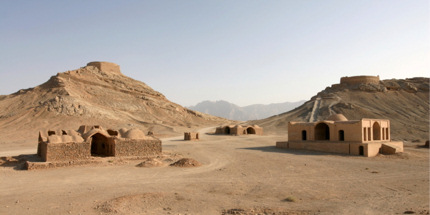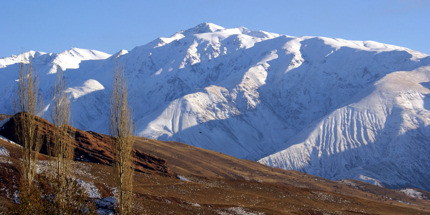Travel to Iran
Iran has been branded with the Axis of Evil label but is one of the friendliest countries in the world. Jini Reddy debunks the myths about this Middle Eastern pariah state.
From luxury hotels to ski resorts, World Travel Guide offers an insider's guide to Iran.
TRAVEL TO IRAN: WHERE TO STAY
Fiction: With few tourists, Iran is short on international-standard accommodation.
Fact: Iran offers 5-star luxury hotels, boutique gems and rural guesthouses with equal panache.
A stay at the 5-star Abbasi in Esfahan is a must. A former caravanserai, it features a courtyard styled like a traditional Persian garden, a fitness centre and pool, bookshop and gift boutique, restaurants, and a traditional tearoom.
Tehran’s sumptuous boutique-style Melal Apartment located in the wealthy northern part of the city offers extensive facilities including gym and fitness suite, free WiFi and a business centre.
Abbas Bazegar runs a guesthouse in the hamlet of Bavanat, in Bazm at the foothills of the Zagros mountains. Ethnically Qashqai, he and his wife have eschewed the nomadic lifestyle, and their home, laden with red woollen tribal rugs, and orchards make this far cosier than any goat herder’s tent.
Insider tip: If you’re staying at the Abbasi, be sure to plump for one of the grand, high-ceilinged suites.
TRAVEL TO IRAN: WHAT TO SEE
Fiction: Iran s a bleak, austere country with little to tempt tourists.
Fact: Iran’s cities are filled with stunning mosques, palaces, lively bazaars, and flower-filled parks, as well as more arcane attractions.
The National Jewels Museum in Tehran is home to a dazzling blingfest. The treasures on display in the underground vault, amassed from royal conquests by various Persian dynasties, include the famous Peacock Throne, encrusted with over 25,000 gems.
Esfahan’s star attraction is Imam Square, one of the world’s largest. The south side is dominated by the Imam Mosque complex which twists towards Mecca, but it’s the smaller Sheik Lotfollah mosque with its staggeringly beautiful dome that leaves visitors awestruck.
The magnificent ruins of Perspepolis, the ancient capital of the Persian Empire, rise from the surrounding plains on a great rock platform. The columns, bas-relief gateways and staircases will leave history buffs speechless with delight.
Insider tip: Don’t miss Esfahan’s covered bazaar, off Imam Square. Save your rials for the miniatures, decorative tiles – and if you’re feeling flush – a rug, or two.
 Visit the Towers of Silence in the ancient desert town of Yazd
Visit the Towers of Silence in the ancient desert town of YazdiStockphoto / Thinkstock
TRAVEL TO IRAN: WHERE TO PARTY
Fiction: It’s a Muslim country, with no nightlife to speak of.
Fact: Locals like to let their hair down just as much as anywhere else – they are just more discreet about it, that’s all.
Do as the locals and visit a chaikhana (teahouse) to sip the brew, or puff on a flavoured shisha pipe. Azedaghan, in Esfahan’s Great Bazaar has an appealingly louche air.
Alcohol is officially banned in the Islamic Republic, but if you must quench your thirst, try the Christian Armenian Club in Tehran. Off-limits to Iranian Muslims, visitors are permitted a drink with their meals.
After nightfall, the courtyard café and tea room at the Abbasi in Esfahan turn into a magnet to the city’s beau monde – who are keen to practise their English on the all-too-rare tourists in their midst.
For a sparkling night out and live music in Shiraz, head to the Sharzeh Traditional Restaurant. The musicians play rousing folk tunes.
Insider tip: In Iran, the wildest parties happen behind closed doors, so befriend a local: this is not as difficult as it sounds for visitors are revered, and invitations are often forthcoming.
TRAVEL TO IRAN: WHERE TO SAMPLE THE CULTURE
Fiction: All artistic expression is banned in Iran.
Fact: Iran has a rich cultural heritage – and is proud of it.
Iranians are passionate about poetry and nowhere is this more obvious than in the vibrant city of Shiraz. Hafez, the most revered of all the Persian poets was born here in the 14th century. He wrote about beauty, love and mysticism, and his tomb is located in an open-air pavilion, in the elegant Musalla Gardens, a wonderful place to visit at sunset.
In Esfahan, visit the Zurkaneh. It means ‘House of Strength’, a place to witness a centuries-old sporting ritual. A team of 10 men enter an octagonal pit in a gym to perform a series of ritualised features. The show, part athletics, part-performance art, part-religious rite, fuses wrestling, aerobics, juggling and sufi-whirling and is accompanied by a male singer and drummer.
The ancient desert town of Yazd is home to Iran’s largest community of Zoroastrians – followers of one of the world’s oldest and most tolerant faiths. Visit the Towers of Silence, where traditionally the dead were left exposed to the elements, and the Fire Temples, a Zoroastrian place of worship.
Insider tip: Hafez’ poetry has given rise to a popular form of fortune-telling, so be sure to have a go: the custom is to open a page of his verse at random, read it and divine your fortune in his words. In Shiraz, you’ll have no trouble finding a local to translate.
 Iran’s ski resorts are a little-known gem in the Alborz Mountains
Iran’s ski resorts are a little-known gem in the Alborz MountainsiStockphoto / Thinkstock
TRAVEL TO IRAN: WHERE TO EAT
Fiction: It’s kebabs and rice all the way.
Fact: Iranian food is a rich combination of flavours and culinary influences.
The restaurant scene in Iran is blossoming – and whether you’re after a Persian feast, chic fusion food or a bite on the run, you’ll find a surprisingly varied selection.
A must-try is the Iranian speciality dizi, a rich stew of chickpeas, lamb and flatbread, cooked and served in a stone jar. The atmospheric Seray-e Mehr Teahouse in Shiraz’s covered Vakil Bazaar is a good place to try it.
In Tehran, the hip, friendly Café 78 serves fantastic sandwiches and snacks, great coffee and speciality teas. The décor reflects its bohemian patrons, with contemporary art and photographs by Iranian artists gracing the walls.
Iranians have a weakness for sweets: at the Haj Khalife shop in Yazd, you can buy sohan, a brittle caramel candy, and gaz, a chewy pistachio nougat, and the order will be packaged up in a ribbon-tied box.
Insider tip: Don’t miss the fesenjan, a traditional dish made with walnuts, pomegranate and chicken at Namakdoon, the restaurant in Tehran’s Laleh International Hotel. The mirrored décor and live music is every bit as enticing as the food.
TRAVEL TO IRAN: WHERE TO FIND ADVENTURE
Fiction: Iran offers cities and highways and not much in between.
Fact: Little-visited rural Iran is a must for those seeking off-the-beaten track adventure and untrammelled landscapes.
Head north into Zarabad, a village in the Alamut Valley. It’s a picturesque area that’s filled with meadows, streams and steep hills, and perfect for hikes. The valley is also home to the remains of the castle hideaways of a 13th century sect known as the Assassins, who ritually plotted the death of their political enemies.
Bazm, in the foothills of the Zagros Mountains, is the perfect base from which to track the Qashqai, the best known of Iran’s nomadic tribes who pasture in summer amidst a landscape of peaks and semi-desert scrubland. The Qashqai, though shy, will welcome you into their tents with glasses of tea.
Iran’s ski resorts are a little-known gem: Shemshak, Darbandsar and Dizin, are a few hours north of Tehran, in the Alborz Mountains. All offer dry, powdery snow conditions, and whilst the first two are favoured by intermediate to advanced skiiers and snowboarders, beginners may fare better at Dizin, considered to be the country's top ski resort, and the closest to the capital. In Iran, the ski season runs from January to the end of March.
Insider tip: The best way to access rural Iran is to join a group tour such as Wild Frontiers (www.wildfrontiers.co.uk).
Do you have any Feedback about this page?
© 2025 Columbus Travel Media Ltd. All rights reserved. No part of this site may be reproduced without our written permission, click here for information on Columbus Content Solutions.









 You know where
You know where